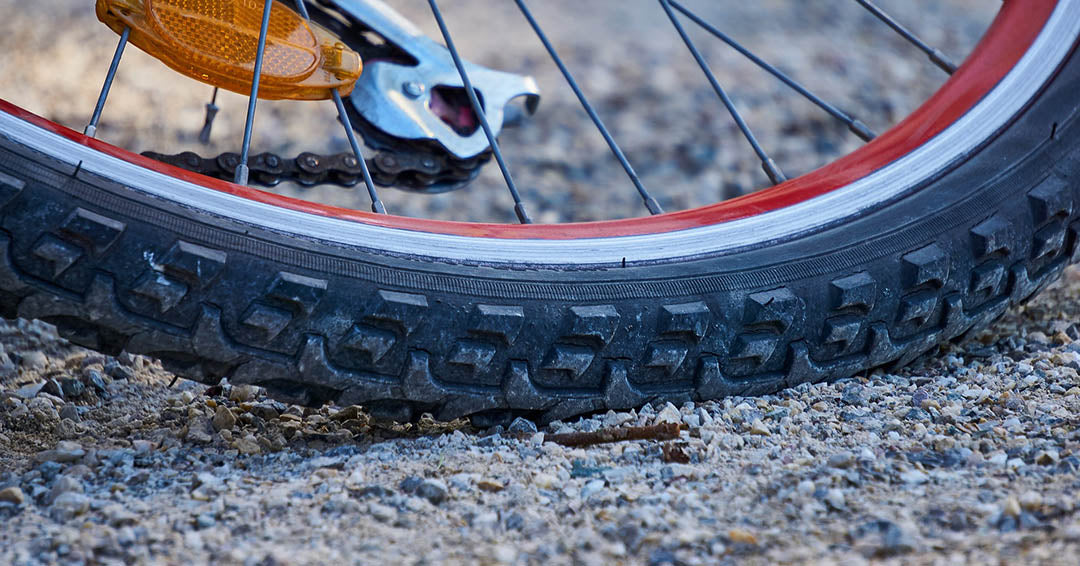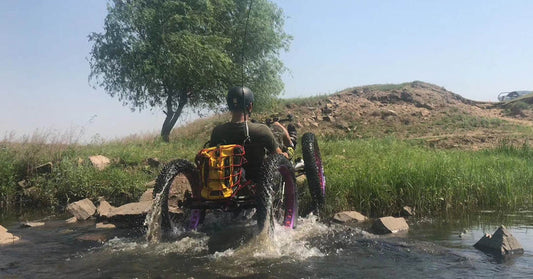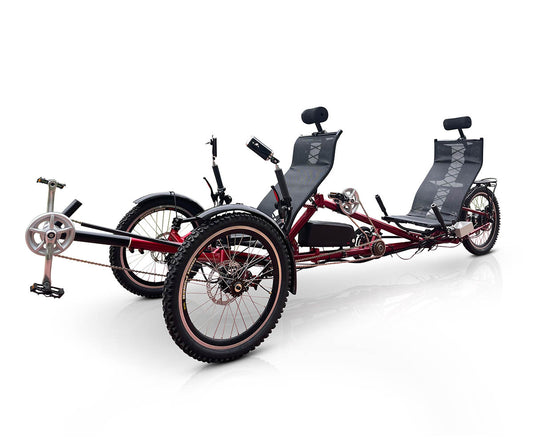
Upgrading Your Ride: The Ultimate Guide to Adaptive Cycling Accessories
Share
Adaptive cycling opens up a world of freedom and enjoyment for individuals with varying needs, transforming the cycling experience into something truly accessible and enjoyable. Selecting the right accessories is crucial to maximize this experience, focusing on safety, convenience, and comfort. This guide aims to provide a comprehensive overview of both essential and optional accessories that can significantly enhance the adaptive cycling experience.
Essential Safety Accessories for Adaptive Cyclists
Ensuring a safe ride is paramount, especially for adaptive cyclists. Here’s how you can optimize each essential safety accessory for maximum protection and visibility:
Flags: The height of the flag can greatly influence visibility. Adjustable flag poles allow you to set the flag high enough to be seen over cars and other obstacles. Flag options are available in a wide variety of shapes, sizes, and designs, offering plenty of choices to match your personal style and complement the look of your ride. For those looking to stand out even more, light-up flags are an excellent choice for visibility and can look downright mesmerizing, especially in lower light conditions. Optimal Option: A flag height of at least 6 feet (about 1.8 meters) above the ground is recommended to ensure it’s visible from a distance in various environments.
Lights: For lights, both brightness (measured in lumens) and placement are adjustable. Front lights should illuminate the path ahead, while rear lights signal your presence to those behind you. Optimal Option: A front light with at least 800 lumens is ideal for clear visibility at night, coupled with a flashing rear light of about 100 lumens to catch the attention of drivers and other cyclists.
Horns: Horns can have adjustable volume settings. In busy urban areas or on shared paths, having a horn that’s loud enough to alert others but not startle them is crucial. Optimal Option: A horn that can emit sound at 90-120 decibels, adjustable based on your riding environment, ensures you’re heard without causing undue distress.
Mirrors: Mirrors are particularly important for recumbent adaptive bikes, where the rider’s ability to perform head checks is limited by the reclined seating position. Look for mirrors with adjustable positioning to get a clear view of the road behind without straining. Optimal Setting: Position the mirror so it gives you a wide view of the road behind and to the side with minimal movement of your head. The mirror should allow for adjustments in both vertical and horizontal planes to accommodate different riding postures and conditions.
Note on Mirrors: Given the unique seating position on recumbent adaptive bikes, which can make it physically challenging to turn around for head checks, mirrors become an indispensable tool for maintaining awareness of your surroundings. Ensuring your mirrors are optimally positioned and clear can significantly enhance your safety and confidence on the road.
Usage Aids: Making Every Journey Smoother
Adaptive cycling introduces a range of considerations for storage and transport, but with the right accessories, every journey can be made smoother and more enjoyable.
Car Racks for Recumbent Quads and Trikes: Transporting recumbent quads and trikes might seem daunting due to their unique size and shape. Various car rack options exist, from standard flat trailers that add cargo space to specialized top and back mounting racks designed specifically for recumbent cycles. While many racks accommodate single cycles, dual storage solutions like the one seen here are also available but can be a bit pricier. An alternative to these racks is choosing a foldable model of adaptive bike, which not only eases transportation concerns but can also fit well inside small to midsize SUVs and hatchbacks. Sedan owners, however, might need to opt for a carry rack to ensure their recumbent cycle travels safely with them.
Ramps: Considering the lightweight materials used in many recumbent bikes, lifting them might be feasible for some. However, for individuals who find lifting their trike a challenge, a variety of ramps are available to aid in loading and unloading the cycle from a vehicle. These ramps are designed to minimize friction in the transportation process, ensuring that everyone can bring their favorite recumbent bike along for the adventure, regardless of physical strength or the bike's weight.
Bags and Storage Solutions: One of the distinct advantages of recumbent bikes, especially three- or four-wheel models, is their ample storage capacity. Unlike standard bicycles, which often offer limited or no storage, recumbent cycles offer extensive options for storage solutions. Whether for recreational touring, commuting, or running daily errands, manufacturers provide a wide range of storage accessories designed to keep your belongings secure and organized without compromising the cycling experience. From built-in compartments to attachable bags, there’s an abundance of choices to suit any need, making recumbent cycling a practical option for a variety of activities.
By considering these aids, cyclists can greatly enhance their adaptive cycling experience, ensuring safety, convenience, and comfort on every ride.
Stationary Trainers | Keeping the Ride Going Indoors: For those days when the weather isn't inviting or your schedule doesn't allow for a trip outdoors, stationary trainers offer a perfect alternative to keep your cycling routine uninterrupted. Stationary trainers are devices that allow you to use your bike, including recumbent trikes and quads, in a stationary position. They are designed to transform your cycle into a stationary bike trainer; holding the non-driving wheels securely, while providing a rolling mount for the drive wheel (or wheels) allowing the user to pedal freely as they would during any ride.
These clever little devices not only enable you to enjoy the cardiovascular benefits of cycling from the comfort of your home but also let you do so on the seat you love. With recumbent cycles already known for their ergonomic advantages, including the comfortable seating position, a stationary trainer enhances your indoor cycling experience by eliminating the need for traditional, often uncomfortable, stationary bike seats.
In order to ensure a quieter indoor training session, it can be handy to have a set of road tires or tires with smoother treads, especially if your recumbent cycle typically sports off-road or mountain bike tires. If you haven't swapped wheels on a bike before, don't worry; you don't need to be a mechanical expert to make the switch, many models of adaptive bikes come with quick-release wheels that make swaps fast and easy.
By integrating a stationary trainer into your cycling regimen, you maintain the flexibility to train under any conditions, ensuring that your fitness and cycling skills continue to grow, regardless of external factors.
Maximizing Comfort with Adaptive Cycling Aids
Adaptive cycling is about more than just mobility; it's about enjoying every moment on the road or trail with the utmost comfort. Thankfully, a wide range of adaptive cycling aids can enhance the riding experience, ensuring every journey is as enjoyable as it is comfortable. Here are some key aids designed to maximize comfort for adaptive cyclists:
Headrests for Enhanced Neck Support: Long rides can put a strain on even the most experienced cyclist's neck. Adaptive bikes and trikes equipped with headrests provide crucial support, reducing fatigue and allowing riders to relax and enjoy the scenery. Adjustable headrests ensure a perfect fit for every rider, making long distances more manageable and enjoyable.
Seat Padding for Ultimate Comfort: The right seat can make all the difference on a long ride. Adaptive cycling seats come in various shapes and sizes, tailored to fit the rider's body and needs. Additional seat padding can be added for extra comfort, with materials ranging from memory foam to gel cushions, ensuring that every ride is a smooth one. Custom seat options are also available, designed to offer the perfect balance of support and cushioning.
Assist Bar/Versa Bars for Accessibility and Balance: Getting on and off an adaptive bike or trike should be effortless and safe. Assist bars, also known as versa bars, provide the support riders need to mount and dismount with ease. Positioned strategically on the bike, these bars can be grasped for balance and leverage, making them an essential aid for individuals requiring extra stability.
Foot and Leg Rests for Optimal Positioning: Proper leg positioning is crucial for comfort and efficiency while cycling. Adjustable foot and leg rests allow riders to find the ideal position, reducing strain and improving circulation. Especially important for recumbent bikes and trikes, these rests support the legs in a natural alignment, enhancing overall ride quality.
Custom Handlebars for Ergonomic Control: Handlebars play a significant role in how a bike feels and handles. Adaptive cycles offer a variety of handlebar designs and configurations, from under-seat to over-seat steering, each providing a different level of control and comfort. Customizable handlebars allow riders to adjust the height, angle, and distance to their preference, ensuring that steering feels natural and effortless. Most models come with handlebars that allow you to adjust their pitch and angle to find the most comfortable position for your riding experience.
With these adaptive cycling aids, riders can tailor their bikes and trikes to meet their exact comfort needs. From supportive headrests and plush seat padding to ergonomic handlebars and stability-enhancing assist bars, the options are vast and varied. Embracing these aids not only maximizes comfort but also enriches the cycling experience, inviting riders to explore further and more frequently.
Additional Customization Options for Adaptive Cycling
Optimizing your adaptive cycle with key accessories enhances safety, comfort, and the overall cycling experience. There are innumerable ways to customize and change your cycle beyond what is detailed above. Here are just a few more, but bear in mind that everything we have covered in this article only scratches the surface of the possibilities.
Chain Guards: Essential for keeping your clothing and the chain itself clean and safe. Especially important for adaptive cycles to avoid any accidents involving the drivetrain.
Pedal Crank Shorteners: Allow riders to adjust the pedal’s distance from the seat, ensuring a better fit for those with shorter legs and enhancing pedaling efficiency.
Chain Tensioners: Keep your chain at the ideal tension for smooth gear shifts and to prevent it from slipping off, a simple upgrade that can significantly improve your ride's reliability.
Gear Mounts: Offer a secure way to attach various items to your cycle, from navigational aids to hydration systems, ensuring everything you need is within easy reach without adding bulk to your ride.
Tips for Choosing and Using Adaptive Cycling Accessories
Choosing the right accessories for your adaptive cycle is crucial to enhancing your riding experience. These tips will help you select and utilize accessories to meet your specific needs, ensuring safety, comfort, and convenience on every ride.
Identify Your Needs: Start by assessing your cycling routine and identifying areas where you need more support, safety, or convenience. Whether it's improving visibility for urban commutes or adding storage for long tours, knowing your priorities will guide your accessory choices.
Compatibility and Installation: Ensure that the accessories you choose are compatible with your adaptive cycle. Check the manufacturer's recommendations and consult with specialists if necessary. Look for accessories that offer easy installation or quick-release features, allowing you to make adjustments or swap out accessories without hassle.
Adjustability and Flexibility: Opt for accessories that offer adjustability, such as telescopic flags, angle-adjustable mirrors, or crank shorteners with various settings. This flexibility allows you to customize the fit and functionality of each accessory to your personal preferences and requirements.
Safety First: Prioritize accessories that enhance your safety on the road, like high-visibility flags, bright lights, and reliable mirrors. Safety accessories are not just optional; they're essential to ensuring you can enjoy cycling with peace of mind.
Note: While many places are slowly becoming more cyclist friendly, for those spending time on or near the road, it can be super helpful to stay cognizant of the basics of bike safety. The National Highway Traffic Safety Administration has a great resource if you want to dig into basic cycling safety tips or even dig deeper into national cycling safety stats within the United States.
Quality and Durability: Invest in high-quality accessories that can withstand the rigors of your cycling adventures. Durable materials and robust construction ensure that your accessories will last, providing value and reliability in the long run.
Seek Expert Advice: Don't hesitate to seek advice from adaptive cycling specialists or experienced riders. They can offer valuable insights into the best accessories for your specific needs and share tips on optimizing their use.
Test and Adjust: Once you've equipped your cycle with new accessories, take the time to test and adjust them as needed. Personal comfort and efficiency are key, so fine-tune each accessory to achieve the perfect setup for your rides.
By carefully selecting and using adaptive cycling accessories, you can transform your cycling experience, making each journey more enjoyable, comfortable, and safe. Remember, the goal is to tailor your adaptive cycle to fit your lifestyle perfectly, opening up a world of possibilities on the road or trail.
Towards the Perfect Ride
In exploring the vast landscape of adaptive cycling accessories, it becomes clear that the right choices can profoundly impact your riding experience. From enhancing safety with high-visibility flags and lights to ensuring comfort through ergonomic adjustments and convenience with practical usage aids, each accessory serves a purpose in crafting a ride that's uniquely yours. This guide merely scratches the surface of possibilities, inviting you to delve deeper into customizing your adaptive cycle to perfectly match your needs and desires.
Whether you're embarking on new adventures, improving your fitness, or simply enjoying the freedom of the open road, the journey is as enriching as the destination. Adaptive cycling opens up a world where mobility meets joy, where each pedal stroke brings you closer to the ultimate cycling experience.
Discover More: If this guide has sparked your interest in further enhancing your ride, we invite you to explore our range of rider experience focused adaptive cycles. From touring and off-road trikes, to handcycles, and therapeutic tricycles, there are options to fit each rider’s aspirations and individual needs. Your next ride could be even more comfortable, safe, and enjoyable—let's make that possibility a reality together.


